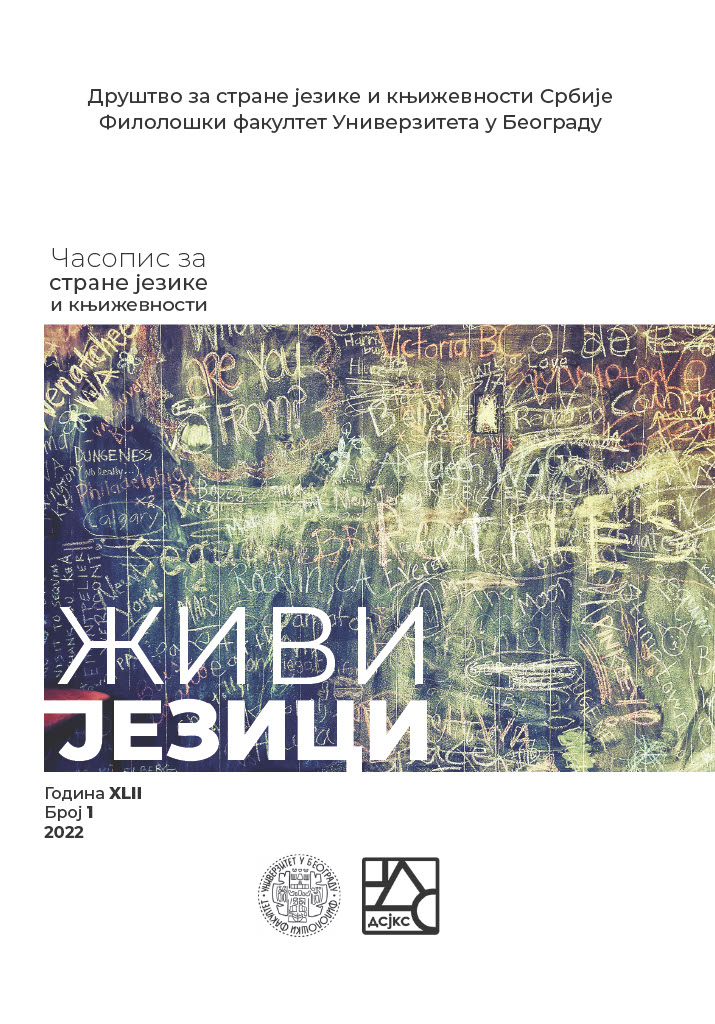Presence of idioms with the component "eye" in the translation of the Bible into Italian, Spanish and Serbian
DOI:
https://doi.org/10.18485/zivjez.2022.42.1.3Keywords:
Bible, idioms, eye, equivalence, Italian, Spanish, SerbianAbstract
The subject of this paper is the analysis of idioms with the component "eye" that exist in today's phraseological fund of Italian, Spanish and Serbian, as well as their presence in the translation of the Bible into these languages. Using the method of contrastive analysis the type of equivalence between them was established, assuming that the existence of absolute translational equivalence between the idioms of three typologically (un)related languages would imply absolute equivalence in translations of the Bible text. Italian was the source language, and Spanish and Serbian the target languages. The aim of the research was not to find those idioms that have biblical origin, but to find somatisms with the component "eye" present in today's phraseological corpus of three analyzed languages, in order to determine if their use is equally represented in analyzed translations and if there are deviations and asymmetries in the translation. The results of the analysis showed the existence of similarities, but also of formal interlingual divergence in the translation, even in cases where there is absolute equivalence between idioms, although the semantic realization of the verses remained unchanged.
References
Ahtmajer 1996: P. J. Achtemeier, Bible Dictionary. San Francisco Harper: Collins Publishers.
Bekaria 1999: G. L. Beccaria, Sicuterat. Il latino di chi non lo sa: Bibbia e liturgia nell'italiano e nei dialetti. Milano: Garzanti.
Bojz 2009: C. Boyes, Jezik tijela. Zagreb: Kigen d.o.o.
Dobrovoljski i Pirainen 2005: D. Dobrovol’skij, E. Piirainen, Figurative language: cross-cultural and cross-linguistic perspectives. London/Oxford: Elsevie.
Dragićević 2007: R. Dragićević, Leksikologija srpskog jezika. Beograd: Zavod za udžbenike.
Fink-Arsovski 2016: Ž. Fink-Arsovski, Što čini razliku? (Tri novija frazeološka kalka u hrvatskom jeziku). U Ž. Čelić, T. Fuderer, Tetyana (ur.), Slavenska filologija. Prilozi jubileju prof. em. Milenku Popoviću (str. 80–88). Zagreb: FF press.
Halas 2012: A. Halas, Pojmovni obrasci u srpskim i engleskim idiomima sa nazivima delova lica. Zbornik Matice Srpske za filologiju i lingvistiku, 55(1), 279–292.
Kamings 2004: E. Kamings, Sve o simbolima. Beograd: Narodna knjiga Alfa.
Korpas Pastor 1996: G. Corpas Pastor, Manual de fraseología española. Madrid: Gredos.
Korpas Pastor 2003: G. Corpas Pastor, Acerca de la (in)traducibilidad de la fraseologia. In G. Korpas Pastor (ed.), Diez años de investigación en fraseología: análisis sintáctico-semánticos, contrastivos y traductológicos (pp. 275–310). Madrid: Iberoamericana.
Meljado Blanko 2002: C. Mellado Blanco, Grados de idiomaticidad en fraseologismos del alemán y del español. In L. Iglesias Rábade, S. Mª. Doval Sánchez (eds.), Studies in Contrastive Linguistics. Proceedings of the 2nd International Contrastive Linguistics Conference (pp. 653–661). Santiago de Compostela: Universidad de Santiago de Compostela.
Meljado Blanko 2017: C. Mellado Blanco, Locuciones y proverbios de origen bíblico: creación y difusión em alemán y español. Revista de Letras, 36 (1), 52–69.
Paeze 1988: A. Paese, Body language, How to read others’ thoughts by their gestures. Oxford: University Printing House.
Ribarova i Vidović Bolt 2009: S. Ribarova, I. Vidović Bolt, Biblijski zoonimski frazemi u hrvatskom, češkom i poljskom jeziku. U D. Sesar (ur.), Slavenski jezici u usporedbi s hrvatskim I (str. 163–170). Zagreb: FF press.
Ševalje i Gerbran 2018: J. Chevalier i A. Gheerbrant, Diccionario de los símbolos. Barcelona: Titivillus.
Published
How to Cite
Issue
Section
License
Copyright (c) 2022 Marija Vujovic

This work is licensed under a Creative Commons Attribution-NonCommercial-ShareAlike 4.0 International License.


